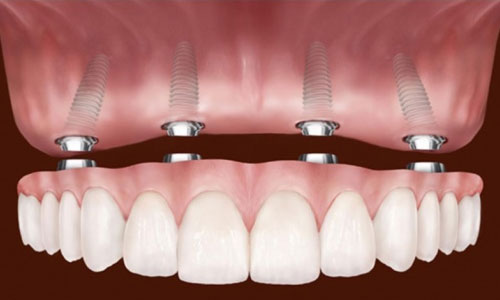9:00 am to 9:00 pm
+91-9810 924 515
The all on 4 implant technique (also known as same day teeth and same day smiles), is a method to replace a full arch of missing teeth (hence "all") with only 4 dental implants (hence "on 4") supporting a fixed denture / bridge all in one day. Normally dental implants are placed into your jaw at a 90 degree angle to your jaw. With the all on 4 technique the 2 implants at the front are fitted as usual at 90 degrees and the 2 implants at the back of the jaw are placed at 45 degrees to your jaw. When a bridge is then attached to the 4 implants this angled placement of implants locks all 4 implants together and enables them to heal and integrate with minimal chance of failure or becoming dislodged. Also since the 2 rear implants are placed at 45 degrees this allows longer implants to be used in this area and is especially important for patients who may otherwise require bone-grafting due to minimal bone tissue in that area. In many cases all on 4 provides a solution for patients who could not previously have implants due to lack of bone.

In order for your dentist to properly evaluate your mouth, requirements and suitability for all on 4 implants you will need a consultation where you will discuss various aspects of the treatment and also your medical history. You may need a series of diagnostics including x-rays a CT scan, measurement of bone density and impressions. This will provide your dentist with information in order to plan your treatment and determine if you will need to have any existing teeth extracted. Many dentists use specialised software and a dedicated treatment planning system such as the NobelGuide system which allows for detailed diagnostics such as identification of available bone structure, virtual implant placement according to the patient's anatomical situation and prosthetic needs and a bespoke surgical template which ensures guided and exact implant placement.
Following this diagnostic appointment if no bone grafting or further treatment is required prior to the implant surgery, your surgical appointment will be scheduled, during which teeth will be extracted (if necessary), implants will be placed and your prosthesis will be fitted all in the same appointment.
Following any extractions, four implants will be placed in the jaw in such a way that the bone will surround, anchor and secure them into place. The implants that are placed in the back part of the jaw will be placed at an angle of approximately 45 degrees to achieve maximum contact and anchorage to the existing bone structure.
Once the four implants have been placed in the jaw, the abutments (a component which connects the implant to the teeth / bridge / denture) will be attached to the implants. The new replacement teeth are then fastened to the abutments and adjusted to ensure a perfect bite is achieved with maximum comfort. Since only four dental implants are used in the procedure (compared to 6-8 in traditional full arch implant dentistry), the entire process is much less invasive and time consuming.
Following this there will be follow up appointments over the next 6 months or so. Approximately after 6 months the gums will be fully healed implants and completely fused to the natural bone. At this stage, depending on your treatment plan your dentist will remove your teeth and take new impressions in order to prepare a final, stronger, permanent set of teeth which are adjusted to a perfect fit.
| All on 4 | Conventional full arch implants |
|
|
Using a standard implant technique where all implants are placed into the jaw at 90 degrees often requires at least 6 dental implants to support full arch and then these are left to heal for 6 months before a fixed bridge can be fitted to the implants. If the patient does not have enough bone then bone grafting may be also required. The standard technique not only takes longer but it is also more expensive (6 implants vs 4, additional bone grafting and more visits to the dentist).